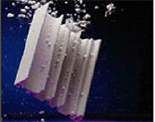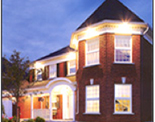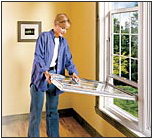 The compound uPVC, principal material which uses the manufacture of our doors and windows, is a polyvinyl chloride not plasticized (Note: "U" does not refer to UV or ultraviolet rays). This kind of vinyl, containing oil and ordinary salt, can be recycled.
The compound uPVC, principal material which uses the manufacture of our doors and windows, is a polyvinyl chloride not plasticized (Note: "U" does not refer to UV or ultraviolet rays). This kind of vinyl, containing oil and ordinary salt, can be recycled.
Caracteristics of vinyl:
- High strength counters abrasion, corrosion, pollutants of the air and insects.
- Definitely higher energy effectiveness
Security nature
The vinyl has been used for more than 50 years. During this long period, it was tested on the plan of its security and its reliability.
 The international Energy Star symbol is a simple way for the consumers to identify products which are energy effective on the market.
The international Energy Star symbol is a simple way for the consumers to identify products which are energy effective on the market.
Here a list of criteria which take into consideration the choice of the models of doors and windows .
.
Appearence
- Dimensions et configurations
- Style
- Frame material
Goal
- Confort
- Resistance to condensation
- Ventilation
- Soud-proofing
- Maintenance
Energy effectiveness
- Standards (test)
- Annual Output: head and cold
- Long-term reliability
- Powerful glass
Costs
- Material and installation
- Maintenance
- Resale value
- Heating annual costs
Interior condensation
 Condensation occurs when the water content inside the house is too high, and this, especially in cold weather. In fact, the doors and windows are not at the origin of this problem, but they indicate if the water content is excessive.
Condensation occurs when the water content inside the house is too high, and this, especially in cold weather. In fact, the doors and windows are not at the origin of this problem, but they indicate if the water content is excessive.
Indices of condensation
- Freezing on the handles of door and the hinges
- Water or plates of ice on the windows
- Rings of moisture or moulds on the walls and ceilings
- Mist on the taps and the pipes of cold water
| Outside temperatures | Inside humidity |
| 20 to 40 °F (-5 to 4 °C) | Never exceeding 40 % |
| 10 to 20 °F (-11 to -6 °C) | Never exceeding 35 % |
| 0 to 10 °F (-16 to -12 °C) | Never exceeding 30 % |
| -10 to 0 °F (-22 to -17 °C) | Never exceeding 25 % |
| -20 to -10 °F (-28 to -23 °C) | Never exceeding 20 % |
| -20 °C or less -28 °C or less |
Never exceeding 15 % |
Exterior condensation
External condensation on the sealed units is a common phenomenon which occurs on high performance windows.
External condensation is usually noted under the following conditions:
- High relative humidity (e.g.: ext temperature close to the dewpoint).
- Energetic glass.
- Early in the morning.
- Direct exposure to a clear sky in north, the east or the south.
- No wind at all.
If the surrounding temperature is slightly above the dewpoint and that the temperature of glass is slightly below: condensation will be formed on glazed surface.
It is with the arrival of very powerfull energy glass systems, preventing interior heat to escape to the external surface, which we owe the formation of this phenomenon.
It is because the conditions mentioned above seldom coincide that it is not frequent to observe this phenomenon even on sealed units high-output energetics.
When it is seen it, one can be assured that a system of higher fenestration was installed.
If you have a humidifier, close it or less often use it. Other solutions: open a door or a window to ventilate or install hoods of ventilation in the kitchen, the bathroom and the room of washing. The hood and casement windows are perfect for these often hot and wet places.

There are various ways. Search doors and windows equipped with a system multichamber. Why? These rooms of air reduce the transmission of the sound. Our sections contain some much more to deaden the sound.
Search the best cut-cold. They are made so the doors and windows are closed adequately and prevent the escapes of air.
Our triple cut-cold can almost eliminate any sound pollution coming from outside.

Maintenance is tiny: no painting, neither dyeing, nor preventive treatment. You have to clean the frame outside and inside with a cleaning product diluted in water. Use a lava-pane without ammonia for the sashes.
Several of our models with casements have a width of opening of 90 degrees to facilitate cleaning whereas our hung windows rock towards the interior.
Wash these parts with soapy water. Rinse them with clean water to eliminate the surpluses of soap, which ensures a correct operation for longer. You can also apply a layer of lubricant containing Teflon or dry silicone to the hinges.
The condensation on the outer surface of the insulating glazing is a normal phenomenon that can occur under certain atmospheric conditions . This is due to the heat exchange between the glass and the environment. The quality of the glass should not be questioned . Indeed, if conditions are favorable ( clear night sky , light winds , moisture-laden air ) , the temperature of the outer glass insulating glass can be lowered sufficiently so that the moisture in the air condenses on its surface . Can meet these conditions a few times in the fall and spring. Once the outer glass warms , most of the time early morning condensation disappears.
Under equivalent conditions , a less efficient insulating glass allows more heat than insulating glazing energy efficient . This heat warms the outer glass and reduces the possibility that condensation will settle. Less effective insulating glass is therefore less suitable for exterior condensation. By cons , insulating glazing high efficiency helps save energy , reduces condensation on the inner surface of the glass , reduces the risk of mold on the inside edge of the window and improves the comfort of your home , and , throughout the year.
For more information, do not hesitate to contact us or visit Natural Resources Canada or flyers Canada Mortgage and Housing Society .
- Your home - Measuring Humidity in your home , no. 62075
- The air and moisture - Owner's Guide - Problems and solutions , no. 61227


